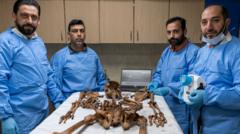Dr. Anas al-Hourani stands in the newly established Syrian Identification Centre, surrounded by tables lined with human femurs from what he describes as a “mixed mass grave.” This facility aims to connect crime with justice as they sort through remains of those believed to be among the hundreds of thousands lost during a decade-long civil conflict in Syria. Many victims are thought to have perished recently, but identification poses a formidable challenge due to limited resources and ongoing civil unrest.
The identification process relies heavily on forensic analysis, particularly of dental remains, which can reveal critical information about the deceased, such as height, sex, and age. However, the lack of available DNA testing facilities due to war damage and sanctions makes the process even more arduous. With only one working DNA lab in the country and costly operations hampered further by what are termed “dual-use” restrictions, officials like Dr. al-Hourani are confronting staggering obstacles.
Funding from the International Committee of the Red Cross is vital, but many families who have been torn apart by loss feel the pace of progress is insufficient. Despite promises of "transitional justice" from the new government, families continue to express frustration and seek faster, more effective resolutions to the grim reality of their missing loved ones. The plight of identification may take many years, as each mixed grave can take months to process even a single victim.
Awareness of the mass graves has grown more pronounced, with eleven such sites noted in the outskirts of Damascus. The international media, including the BBC, gained access to these locations, revealing the harsh realities behind the war's grim toll. Accompanying this exploration is Abu Ali, a former military driver who recalls his harrowing experiences transporting countless civilian bodies during the height of the conflict. His accounts of seeing the bodies, often tortured and mangled, add a haunting dimension to the pain endured by families in search of answers.
Malak Aoude, a mother grappling with the loss of her two sons, speaks to the heart of the suffering felt by many as she details her experiences of waiting and wandering through the remnants of an irretrievable past. Her searches yield only fragments of hope against the backdrop of enduring pain. While the fall of the Assad regime signified a moment of potential liberation, many families continue to grapple with uncertainty about their loved ones, illustrating that even amidst change, the scars of war remain fresh and deeply embedded in the fabric of Syrian society.



















